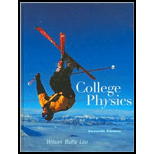
College Physics
7th Edition
ISBN: 9780321601834
Author: Jerry D. Wilson, Anthony J. Buffa, Bo Lou
Publisher: Addison-Wesley
expand_more
expand_more
format_list_bulleted
Question
Chapter 4, Problem 50E
To determine
The tension in the cord between points A and B.
Expert Solution & Answer
Want to see the full answer?
Check out a sample textbook solution
Chapter 4 Solutions
College Physics
Ch. 4 - Prob. 1MCQCh. 4 - A force (a) always produces motion, (b) is a...Ch. 4 - If an object is moving at constant velocity, (a)...Ch. 4 - If the net force on an object is zero, the object...Ch. 4 - The force required to keep a rocket ship moving at...Ch. 4 - Prob. 6MCQCh. 4 - Prob. 7MCQCh. 4 - The weight of an object is directly proportional...Ch. 4 - Prob. 9MCQCh. 4 - A brick hits a glass window. The brick breaks the...
Ch. 4 - Prob. 11MCQCh. 4 - Prob. 12MCQCh. 4 -
The condition(s) for translational equilibrium is...Ch. 4 - Prob. 14MCQCh. 4 - Prob. 15MCQCh. 4 - Prob. 16MCQCh. 4 - Prob. 17MCQCh. 4 - Prob. 1CQCh. 4 - Prob. 2CQCh. 4 - Prob. 3CQCh. 4 - Prob. 4CQCh. 4 - Prob. 5CQCh. 4 - The following is an old trick (Fig. 4.28). If a...Ch. 4 - Prob. 7CQCh. 4 - A student weighing 600 N crouches on a scale and...Ch. 4 - An astronaut has a mass of 70 kg when measured on...Ch. 4 -
In general, this chapter has considered forces...Ch. 4 - Prob. 11CQCh. 4 - Prob. 12CQCh. 4 - Prob. 13CQCh. 4 - Prob. 14CQCh. 4 - Prob. 16CQCh. 4 - Prob. 17CQCh. 4 -
Identify the direction of the friction force in...Ch. 4 - Prob. 19CQCh. 4 - Prob. 20CQCh. 4 - Prob. 21CQCh. 4 - Prob. 22CQCh. 4 - Prob. 23CQCh. 4 - Which has more inertia, 20 cm3 of water or 10 cm3...Ch. 4 - Prob. 2ECh. 4 - In Exercise 2, if the 35-N force acted downward at...Ch. 4 -
A net force of 4.0 N gives an object an...Ch. 4 - Prob. 5ECh. 4 - Prob. 6ECh. 4 - A 5.0-kg block at rest on a frictionless surface...Ch. 4 - (a) You are told that an object has zero...Ch. 4 - A fish weighing 25 lb is caught and hauled onto...Ch. 4 - A 1.5-kg object moves up the y-axis at a constant...Ch. 4 - Three horizontal forces (the only horizontal ones)...Ch. 4 - Prob. 12ECh. 4 - Prob. 13ECh. 4 - Prob. 14ECh. 4 - IE ● A 6.0-kg object is brought to the Moon, where...Ch. 4 - A gun is fired and a 50-g bullet is accelerated to...Ch. 4 - Prob. 17ECh. 4 - Prob. 18ECh. 4 - Prob. 19ECh. 4 - Prob. 20ECh. 4 - Prob. 21ECh. 4 - Prob. 22ECh. 4 - Prob. 23ECh. 4 - Prob. 24ECh. 4 - An object (mass 10.0 kg) slides upward on a...Ch. 4 - In an emergency stop to avoid an accident, a...Ch. 4 - Prob. 27ECh. 4 - A force of 10 N acts on two blocks on a...Ch. 4 - Prob. 29ECh. 4 - In a pole-sliding game among friends, a 90-kg man...Ch. 4 - A book is sitting on a horizontal surface. (a)...Ch. 4 - In an Olympic figure-skating event, a 65-kg male...Ch. 4 -
A sprinter of mass 65.0 kg starts his race by...Ch. 4 - Jane and John, with masses of 50 kg and 60 kg,...Ch. 4 - Prob. 35ECh. 4 - A 75.0-kg person is standing on a scale in an...Ch. 4 - Prob. 37ECh. 4 - Prob. 38ECh. 4 - The weight of a 500-kg object is 4900 N. (a) When...Ch. 4 - A boy pulls a box of mass 30 kg with a force of 25...Ch. 4 - Prob. 41ECh. 4 - Prob. 42ECh. 4 - Prob. 43ECh. 4 - Prob. 44ECh. 4 - Prob. 45ECh. 4 - Assuming ideal frictionless conditions for the...Ch. 4 - Prob. 47ECh. 4 -
A55-kg gymnast hangs vertically from a pair of...Ch. 4 - A physicist’s car has a small lead weight...Ch. 4 - A 10-kg mass is suspended as shown in Fig. 4.41....Ch. 4 - Prob. 51ECh. 4 - Prob. 52ECh. 4 - Prob. 53ECh. 4 - A horizontal force of 40 N acting on a block on a...Ch. 4 - The Atwood machine consists of two masses...Ch. 4 - Prob. 56ECh. 4 - Prob. 57ECh. 4 - Prob. 58ECh. 4 - Prob. 59ECh. 4 - In the frictionless apparatus shown in Fig. 4.43,...Ch. 4 - In the ideal setup shown in Fig. 4.43, m1 = 3.0 kg...Ch. 4 - A20-kg box sits on a rough horizontal surface....Ch. 4 - Prob. 63ECh. 4 - Prob. 64ECh. 4 - Prob. 65ECh. 4 - Prob. 66ECh. 4 - A 1500-kg automobile travels at 90 km/h along a...Ch. 4 - Prob. 68ECh. 4 - Prob. 69ECh. 4 - Prob. 70ECh. 4 - Prob. 71ECh. 4 - Prob. 72ECh. 4 - Suppose the slope conditions for the skier shown...Ch. 4 - Prob. 74ECh. 4 - A block that has a mass of 2.0 kg and is 10 cm...Ch. 4 - In the apparatus shown in Fig. 4.46, m1 = 10 kg...Ch. 4 - In loading a fish delivery truck, a person pushes...Ch. 4 -
An object (mass 3.0 kg) slides upward on a...Ch. 4 - For the apparatus shown in Fig. 4.40, what is the...Ch. 4 - Prob. 81ECh. 4 - Prob. 82ECh. 4 - Prob. 83ECh. 4 - Prob. 84ECh. 4 - Prob. 85ECh. 4 - Prob. 86ECh. 4 - Prob. 87ECh. 4 - Prob. 88E
Knowledge Booster
Learn more about
Need a deep-dive on the concept behind this application? Look no further. Learn more about this topic, physics and related others by exploring similar questions and additional content below.Recommended textbooks for you
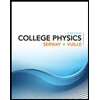 College PhysicsPhysicsISBN:9781305952300Author:Raymond A. Serway, Chris VuillePublisher:Cengage Learning
College PhysicsPhysicsISBN:9781305952300Author:Raymond A. Serway, Chris VuillePublisher:Cengage Learning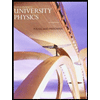 University Physics (14th Edition)PhysicsISBN:9780133969290Author:Hugh D. Young, Roger A. FreedmanPublisher:PEARSON
University Physics (14th Edition)PhysicsISBN:9780133969290Author:Hugh D. Young, Roger A. FreedmanPublisher:PEARSON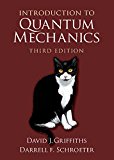 Introduction To Quantum MechanicsPhysicsISBN:9781107189638Author:Griffiths, David J., Schroeter, Darrell F.Publisher:Cambridge University Press
Introduction To Quantum MechanicsPhysicsISBN:9781107189638Author:Griffiths, David J., Schroeter, Darrell F.Publisher:Cambridge University Press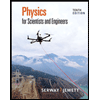 Physics for Scientists and EngineersPhysicsISBN:9781337553278Author:Raymond A. Serway, John W. JewettPublisher:Cengage Learning
Physics for Scientists and EngineersPhysicsISBN:9781337553278Author:Raymond A. Serway, John W. JewettPublisher:Cengage Learning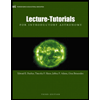 Lecture- Tutorials for Introductory AstronomyPhysicsISBN:9780321820464Author:Edward E. Prather, Tim P. Slater, Jeff P. Adams, Gina BrissendenPublisher:Addison-Wesley
Lecture- Tutorials for Introductory AstronomyPhysicsISBN:9780321820464Author:Edward E. Prather, Tim P. Slater, Jeff P. Adams, Gina BrissendenPublisher:Addison-Wesley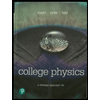 College Physics: A Strategic Approach (4th Editio...PhysicsISBN:9780134609034Author:Randall D. Knight (Professor Emeritus), Brian Jones, Stuart FieldPublisher:PEARSON
College Physics: A Strategic Approach (4th Editio...PhysicsISBN:9780134609034Author:Randall D. Knight (Professor Emeritus), Brian Jones, Stuart FieldPublisher:PEARSON

College Physics
Physics
ISBN:9781305952300
Author:Raymond A. Serway, Chris Vuille
Publisher:Cengage Learning

University Physics (14th Edition)
Physics
ISBN:9780133969290
Author:Hugh D. Young, Roger A. Freedman
Publisher:PEARSON

Introduction To Quantum Mechanics
Physics
ISBN:9781107189638
Author:Griffiths, David J., Schroeter, Darrell F.
Publisher:Cambridge University Press

Physics for Scientists and Engineers
Physics
ISBN:9781337553278
Author:Raymond A. Serway, John W. Jewett
Publisher:Cengage Learning

Lecture- Tutorials for Introductory Astronomy
Physics
ISBN:9780321820464
Author:Edward E. Prather, Tim P. Slater, Jeff P. Adams, Gina Brissenden
Publisher:Addison-Wesley

College Physics: A Strategic Approach (4th Editio...
Physics
ISBN:9780134609034
Author:Randall D. Knight (Professor Emeritus), Brian Jones, Stuart Field
Publisher:PEARSON
Drawing Free-Body Diagrams With Examples; Author: The Physics Classroom;https://www.youtube.com/watch?v=3rZR7FSSidc;License: Standard Youtube License